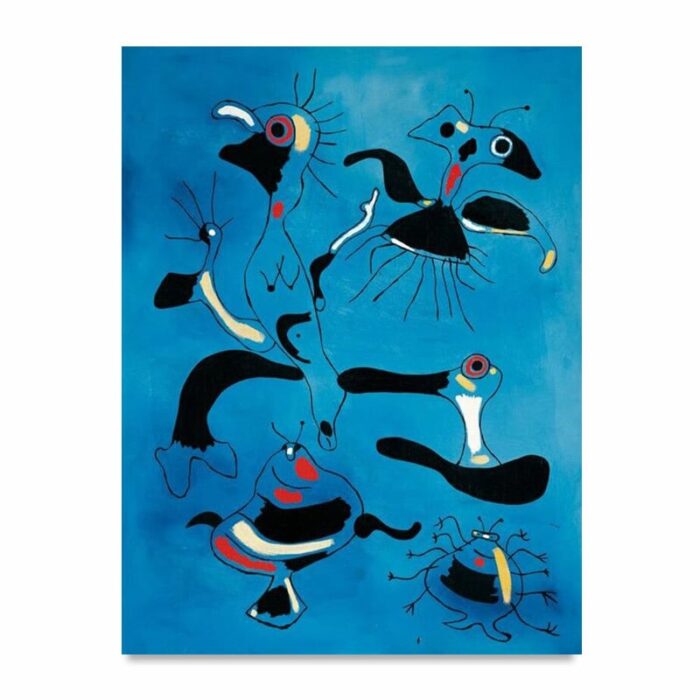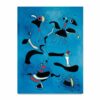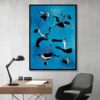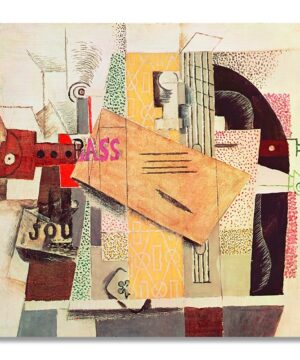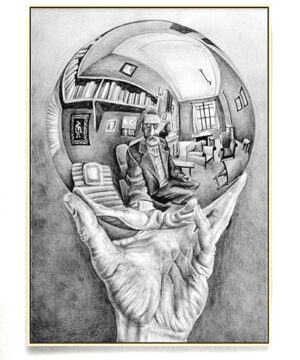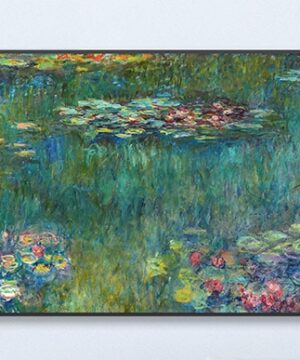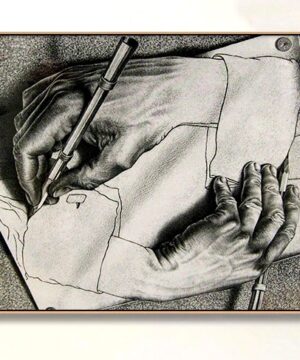Where is Joan Miró’s picture “Birds and Insects” today?
The Joan MiróSpanish Catalan artist Joan Miró (1893 – 1983) is famous for his works in painting, sculpture, and ceramics. His work is strongly influenced by his hometown Barcelona, the scenic seaside, and the distinct style of that area. From early on, he was exposed to the arts through his parents’ professions: His mother was a goldsmith, father worked as a watchmaker. More original of the picture “Birds and Insects” is currently part of a private collectionWhat’s in it?
Joan MiróSpanish Catalan artist Joan Miró (1893 – 1983) is famous for his works in painting, sculpture, and ceramics. His work is strongly influenced by his hometown Barcelona, the scenic seaside, and the distinct style of that area. From early on, he was exposed to the arts through his parents’ professions: His mother was a goldsmith, father worked as a watchmaker. More “Birds and Insects”: Across a sky-blue background, birds are flying across the composition, multi-legged insects with long tentacles either fly or scuttle in between. One of the birds has its sturdy beak opened widely as if loudly singing or screaming. The animals are highly abstracted, completely different to the realistic approaches such as MC Escher‘s insects. A limited colour palette is applied, yet the colours are expressive and bold. The animals are outlined in black and are widely transparent, giving sight onto the blue background. Interspersed with white yellow and red colour fields, a strong contrast with the sky is built up.What’s the context?
Under the influence of writers and poets in Paris, Joan MiróSpanish Catalan artist Joan Miró (1893 – 1983) is famous for his works in painting, sculpture, and ceramics. His work is strongly influenced by his hometown Barcelona, the scenic seaside, and the distinct style of that area. From early on, he was exposed to the arts through his parents’ professions: His mother was a goldsmith, father worked as a watchmaker. More developed his unique style using organic forms and flattened picture planes drawn with sharp lines. Since he made wide use of symbols and explored automatismDefinition and Origin Automatism in art, especially within the Surrealist movement, refers to creating without conscious control. It aims to tap into the subconscious mind, bypassing rational thought. Originating in the early 20th century, automatism was a reaction against traditional artistic methods. Techniques of Automatism • Drawing: Artists create spontaneous drawings, often without looking at the paper. This allows for More, he was generally thought of as a Surrealist and to be influenced by the DadaDada was an avant-garde art movement formed in the early 20th century in Zürich in reaction to the horrors of the First World War. The Dada artists believed that the war called into question any aspect of their society including the creation of art, therefore aiming at the demolition of traditional artistic values. On this basis, a new form of More movement. However, he rejected to officially become a member of any artistic movement during the interwar European periods. Nonetheless, André BretonAndré Breton (1896 – 1966) was a French writer and poet, best known as an original member of the Dada group and one of the founders of the Surrealism movement. His seminal writings include the first Surrealist Manifesto (Manifeste du surréalisme), published 1924, in which he defined surrealism as "pure psychic automatism", encouraging chance and spontaneity in artistic practices. Breton More, the founder of the Surrealist movement, described him to be the “most Surrealist of us all”.Chatter and Prattle
Joan MiróSpanish Catalan artist Joan Miró (1893 – 1983) is famous for his works in painting, sculpture, and ceramics. His work is strongly influenced by his hometown Barcelona, the scenic seaside, and the distinct style of that area. From early on, he was exposed to the arts through his parents’ professions: His mother was a goldsmith, father worked as a watchmaker. More – Facts:- As a child, Joan MiróSpanish Catalan artist Joan Miró (1893 – 1983) is famous for his works in painting, sculpture, and ceramics. His work is strongly influenced by his hometown Barcelona, the scenic seaside, and the distinct style of that area. From early on, he was exposed to the arts through his parents’ professions: His mother was a goldsmith, father worked as a watchmaker. More spent much time exploring nature in his home Catalonia. He liked to watch insects, birds, lizards, trees, and other plants, which would later appear in his art, becoming characteristic features of his artistic language.
- Through analysing personal notes and texts by Joan MiróSpanish Catalan artist Joan Miró (1893 – 1983) is famous for his works in painting, sculpture, and ceramics. His work is strongly influenced by his hometown Barcelona, the scenic seaside, and the distinct style of that area. From early on, he was exposed to the arts through his parents’ professions: His mother was a goldsmith, father worked as a watchmaker. More, scientists have established that he experienced several episodes of depression throughout his life. After his first episode, he stated: “I was demoralized and suffered from serious depression. I fell really ill, and stayed three months in bed’’. Immersing himself in nature as well as paintingPainting is a fundamental form of visual art that has been practiced for thousands of years. It involves applying pigment to a surface such as canvas, paper, or a wall. Painting can be explored through various styles, techniques, and mediums, each offering unique possibilities for expression and creativity. Historical Background • Ancient Beginnings: The history of painting dates back to More served as means to stabilizing and dealing with depression: Without paintingPainting is a fundamental form of visual art that has been practiced for thousands of years. It involves applying pigment to a surface such as canvas, paper, or a wall. Painting can be explored through various styles, techniques, and mediums, each offering unique possibilities for expression and creativity. Historical Background • Ancient Beginnings: The history of painting dates back to More, he became ‘‘very depressed, gloomy and I get ‘black ideas’, and I do not know what to do with myself”.
Joan Miró: Surrealism Through the Eyes of an Abstract Genius
76 Innovative Surrealism Art Ideas to Unleash Your Creative UnconsciousGuillaume Apollinaire, Surrealism and Today’s AI: Above RealityFacts to Know about Surrealism: Changing the Course of Art HistoryFamous Abstract Paintings: Joan Miró Art Works You Must Know10 World Famous Paintings of the Modern Period that changed the Artworld foreverHand with Reflecting Sphere by M. C. Escher – Canvas Giclée Print Further Recommended Readings:This article may contain compensated links. Please read Disclaimer for more info. As an Amazon Associate, I earn from qualifying purchases.Joan Miro et al. (2017): Joan Miro: I Work Like a Gardener (Interview with Joan Miro on his creative process)Carolyn Lanchner (1993): Joan Miro (A Museum of Modern Art Book)Agnes De La Beaumelle (2020): Joan Miró 1917–1934: I’m Going to Smash their GuitarMargit Rowell et al. (2017): Miro and Calder’s ConstellationsMarko Daniel et al. (2012): Joan Miro: The Ladder of Escape
